Elizabeth Moon's Blog, page 19
October 14, 2014
Ebola: Lessons Learned the Hard Way
Lesson One: A stitch in time saves nine. If you want to get classical about it, the "stitch in time" is a subset of that hoary old virtue called Prudence, the foresight virtue. It's noticing early stages of something, thinking out the "What if this goes on?" and how the problem might be alleviated and future worse outcomes prevented--and then doing something about it. It's one of the least common virtues, because it requires expending time and energy and resources on something that hasn't happened yet. That's not something we humans are good at, especially if the time, energy, and resources involved are our own, and not someone else's.
Ebola is not a new health threat; sporadic small outbreaks have taught those who worked where it was that a) it could be contained and b) how to contain it. Its mode of transmission and its potential to spread from nation to nation have been under discussion for decades. The ability of people incubating a serious disease to move globally before their disease becomes evident, thanks to the speed of modern travel, is not new and has been under discussion for even more decades. Ebola specifically has been talked about in medical journals as a one of a number of serious health threats. But...Ebola was "over there" in Africa, the outbreaks were small, and the proposed costs of preparing for its arrival "here" (meaning outside Africa) seemed far too high to spend much time, energy, or money on actual preparedness.
Individuals, medical centers, and governments all chose to ignore the loose stitches in the fabric of global health (inclding a lot more than Ebola) in favor of saving time, energy, and money for other problems. Hospitals did not review their admittance procedures. They did not train staff. They did not stockpile the supplies needed. They did not foresee the need for special handling of Ebola-contaminated trash. Governments did not ensure that clear guidelines were issued, nor did they fund additional research into what it might take to mitigate the threats. Nor did they send assistance to the affected countries the current outbreak occurred, to help contain it. The medical staff who did go were volunteers, not representing their governments, and thus without a clear pipeline to the medical and political establishments back home. Their experience--crucial to setting up protocols to deal safely with the same disease elsewhere--was not transmitted clearly.
In the U.S., states were alloted "disaster" funds after 9/11, and four high-containment treatment units for especially dangerous diseases were in fact set up, one in each of four states (Maryland, Georgia, Missouri, Nebraska), but the use of funds was up to the states themselves and no provision was made to assign all patients with a particular disease to one of them. Two--in Georgia and Nebraska--have been used so far for Ebola patients. One of those, in Nebraska, was considered an unnecessary waste of taxpayer money until they had an Ebola case.
Lesson Two: Hubris kills. The countries remote (they thought) from Africa that also had "modern" medical systems felt secure and comfortable in their medical superiority: their hospitals full of equipment, their staffs well-trained to Western standards, their generally well-fed and healthy patient populations, their reliance on someone else to screen arrivals for signs of any dread disease. Maybe "those people" couldn't deal with Ebola outbreaks--after all, these were poor countries, patients already had compromised health, medical personnel were few and they lacked all the medical bells and whistles a richer country takes for graned. If an Ebola patient showed up out of Africa, the superior medical skills, equipment, and supplies of the receiving hospital would instantly recognize and abate the threat to others, and probably the patient would survive, thanks to advanced care. There was no need to seek out and learn from those who cared for Ebola in Africa, because the greater resources in wealthier countries made their experience irrelevant.
Secure in their assumption of superiority, politicians evaded the need to fund forward-thinking ways to deal with what was (as the best medical advice said) the inevitable arrival of new, serious diseases from overseas and instead bragged on having a wonderful health care system. Secure in their assumption of superiority, government agencies assured themselves (and the public) that their country's existing medical structures would respond promptly and correctly should Ebola appear...without running any checks to see if that was true. Secure in their assumption of superiority, and pressured to cut costs, hospitals shaved preparedness activities to the bone, or simply eliminated them. Public education on unfamiliar diseases (like Ebola) was left to sensationalist media with agendas not based on the public welfare: movies, television programs, talk radio, etc. with the result that most of the public knew only that it was a scary African disease and could kill a lot of people really quickly.
We know now how well that worked. In spite of the fact that the current outbreak has been in the medical news since early last spring, and in the regular news at least since July, hospitals did not immediately leap into action to train staff on the techniques needed for dealing with an Ebola patient. Nor did most of them update their admissions and triage protocols to make detection of Ebola more likely and contamination of other patients and staff less likely. Certainly they were not paying attention to the exact ways volunteer staff in the affected outbreak area went about their work, and why. So when an actual Ebola patient showed up, the systems supposedly in place turned out to have large gaping holes. In Texas Health Presbyterian Hospital, where Mr. Duncan died, his initial ER diagnosis was "sinusitis" and he was deemed "not sick enough" to be admitted.
In both the US and UK, the shock of finding out that superiority wasn't as superior as had been thought shook public confidence in medical systems, and medical staffers' confidence in themselves. In a few clinics where someone showed up stating he or she might have Ebola, staff refused to come near them and clearly did not know what to do. Some clinics and hospitals experienced staff shortages due to staff concerns. Nursing organizations complained that they hadn't had proper training and the protective gear now shown wasn't even available where they worked...yet nursing organizations, just like medical societies, had access to information about Ebola years before. With no automatic referral of Ebola patients to the specialty units, including safe transport from their current location to such a unit, Ebola patients could--as Mr. Duncan did--appear at hospitals completely unprepared to recognize or care for someone with Ebola. When hubris is shown up as hubris, when those smugly certain they had a situation under control find they didn't--the resulting shock can render existing systems unstable--individuals no longer know what they know, since they've just found out it wasn't as much as they thought. And in that situation, individuals may perform worse than they did before, not better. Any chaotic situation means people at risk. THPH closed its Emergency Department (reasons not stated)--so where will sick people in its area go now? Ebola is not the only killer: where will people with malaria, heart attacks, strokes, TB, and trauma go?
Lesson Three: Privatisation is no guarantee of quality performance. Despite claims by conservative politicians that the United States has the best health care system in the world, this crisis (and others ) have shown that the health care system here is deficient in the main goal of any health care system: enabling a healthier populace. At enormous cost, the U.S. has accepted a health care system that enriches insurance companies, pharmaceutical companies, for-profit hospital groups, medical equipment manufacturers, etc, while failing to provide adequate basic health care to large segments of the population. We have all the shiny--all the machines, all the specialists, all the big hospitals, all the extras--anyone could hope for, but we do not have a sound basis for a good health care system: access for every citizen, regardless of income, to swift, accurate diagnosis and treatment, and to the underlying necessities of a healthy life: access to clean air, clean water, sufficient healthy and uncontaminated foods, decent housing, space for children and adults to exercise safely, quality education, and meaningful work. That's why the basic health statistics in the U.S. have slipped year by year so the only thing we're #1 in is the cost of health care.
Lack of universal access results in the early stages of both communicable and so-called "lifestyle" diseases going undiagnosed and untreated because many people do not have the money to pay for discovery and treatment. When Mr. Duncan appeared in the Emergency Room of Texas Health Presbyterian Hospital--a black, foreign, uninsured person--staff saw that, not the possibility that he had Ebola. Emergency Departments in most hospitals lose money--it's where poor people go, who don't have insurance or money for illnesses that people with resources go to doctors' offices for. The ER is a drain on other hospital resources and thus there's pressure from hospital administrations to get the non-payers out of there fast. THPH, like all privately owned hospitals, had a bottom-line responsibility, and bottom-line priority is always a risk to quality patient care. A hasty misdiagnosis of Mr. Duncan led to endangering not only his life, but the lives of staff, other patients, and those who contacted him outside the hospital, including his own family. THPH isn't a monster: It is an average hospital, representative of how many hospitals are run, in a national health care "system" that does not put public health or the health of individuals (if they're poor, especially) first. Privatisation privileges profit, the bottom line, over patient welfare. In any nation that values private enterprises, the tension between private and public agendas must be monitored with care.
Lesson Four: Fear is faster than facts. Biology makes us sensitive to threats--if you don't notice the lion, you get eaten. But away from the very plain threats of lion, tiger, flood, fire, humans are generally bad at analyzing the relative danger of threats. Which is more dangerous, your forty-minute commute, or Ebola in your state? Which is more likely to kill you within the next 12 months? The commute, of course. But you're a good driver--you're sure of that--and it's a familiar route, and it's not scary. Ebola is scary...your imagination, faster than a speeding bullet, leaps the tall buildings of likelihood in a single bound and you are convinced that Ebola is the big bad lion crouched to spring. If you have certain personality traits, anyone trying to give you the facts about Ebola will strike you as a fool or a tool of some conspiracy (involvind the government, of course) and you will reject the facts in favor of nursing your own particular fear. You will be helped in this by the ignorant and ambitious fear-mongers who are eager to push you towards other actions or opinions for their own reasons. If you're detached from the fear, it's easier to see them work---they use Ebola as a tool in their argument for "closing the border" or "ending waste in Washington" or any other political or economic end.
It's hard not to react to the efforts of others to engender fear--we're social animals, and we are affected by others' emotions. But panic is not a good basis for action. It's impossible to think when panicking, and hard to think when scared at all. Yet when a threat is not imminent (the lion is two miles away, not about to spring at you) taking the time to ascertain the facts (that lion is two miles away and there's not another lion any closer) and act on facts, not fear, produces better results. Most of us know that, when nothing scary is going on. But the requirement of rational action--stopping to learn the facts, to think clearly, to act accordingly--takes time, and can feel as if "nothing's being done" and something should be. Learning not to panic, but think--that takes training (and it helps if it starts in childhood.) In most situations (there are exceptions and learning to tell the difference is important), slowing down to think improves the chance of a better outcome. Is this threat immediate? Is it a day away? A week? A month? Next door? Down the street? Across town? Hundreds of miles away? If it's a threat you know little about, if it's really a new threat, something no one anticipated, then accept that the facts won't be known for awhile (nobody has all the facts) and ignore those who want to throw their favorite conspiracy theory onto the new emergency.
Two more ancient virtues help: temperance, the habit of, and ability to, control your emotions and desires, and courage/fortitude, the habit of not giving in to fear and panic.
Lesson Five: Change takes time. A system cannot change in an instant. Either you take the time to notice that your pants have a few stitches gone in the seam, and take the time then to fix it, or when it's an obvious and embarrassing split, you take more time to fix it then. Medical care systems are made up of "paper" as well as people, drugs, machine, and buildings: they are made of protocols, routines, habits. I have read a clear description of the protocols used in one hospital in Liberia for treating Ebola patients: that does not mean I could perform it, put on and take off the protective clothing without contaminating myself. I don't have the right habits; I don't have the right background of training and experience that builds the right habits. (Six years in EMS wasn't enough, and that was thirty years ago anyway.) Moreover a systerm reacts to any change with other changes--some of them difficult to predict, and discovered in practice. Systems that work tend to stabilize and then to protect that stability (whether it's what you wanted or not.) To change an existing system's way of working requires careful analysis and firm goals--and the willingness to put in the time, energy, and money necessary to overcome the system's inertia. Behind one missed diagnosis--or one successful diagnosis--lies a whole system. If making critical diagnoses of rare conditions is a priority, then time, energy, and money must be spent to make that one rare diagnosis possible.
Time: Staff must be educated, and a single half hour to three hour training session with someone talking, a handout, and some slides is not enough. Where behaviors need to be changed, only practice works...and the practice cannot be just rote, but intelligent, responsive practice. Variations on the presentation of an emergency build a depth of skill in personnel that repeating the same exercise over and over does not. If the behaviors are rarely used, then they must be practiced frequently enough to maintain the skills, which takes time from other duties.
Effort: Planning and executing change is not easy, and exercises to break one habit and make another are difficult and often frustrating. As the change begins to take hold, the unanticipated consequences show up, and must be dealt with. People experienced in systems design and management in real-life systems are often hard to find (not everyone who claims that skill has it.)
Money: To institute and maintain change in a system requires money--both to initiate it and to maintain it, as it requires staff time beyond existing duties. In the case of medicine, it also requires maintaining an inventory of supplies that may not be needed except at long intervals. Changes in protocols may also require money--if, for instance, it become standard to transfer patients with a given disease to a specialty center, then some entity must pay for that transport.
Is it possible to ensure that every hospital in the world will be able to recognize and handle a case of Ebola without transmission to a staff member or other patient? Probably not. Is it possible to ensure that every hospital in the United States will be able to do so? Maybe, but unlikely. Is it possible to ensure that every 300+ bed hospital in the United States can follow a simple protocol that identifies the probability that someone has Ebola, and take the correct steps to protect staff and other patients from contamination while awaiting more expert assistance? Probably...but not by next week, or next month. Too many hospitals, too many different organizations involved, and no central authority to enforce a common standard. CDC can give advice, but has no power to compel compliance with its advice, besides being underfunded and understaffed. Political forces in the US--anti-science, anti-regulation, anti-government--mitigate against any effective national policy.
The light bulb has to want to change. Does this lightbulb? Too early to tell.
Lesson Six: Everything is connected to everything else. A disease outbreak in one country affects people in distant countries--even before someone with a disease arrives, it spreads panic, it changes individual goals, it impacts governments' policies.
A hospital's desire for a business award affects its policies and procedures in its Emergency Department. Fear affects whether an apartment complex will provide space for someone related to a patient with a certain disease.
Some connections are unreasonable, but they still have an effect--they're still "real" in a psychological sense: they change behaviors. When a Texas politician wants to spend money "closing the Mexican border" instead of improving hospitals' response to sick people--that's not smart, but it is a connection in his mind between "foreigners" and "disease." (His grasp of the overall disease burden in this state and where it comes from is...minimal.)
There is no bunker deep enough, no ivory tower high enough, no wall stout enough, or weapons system powerful enough to keep what happens "there" from affecting life "here." We are part of a larger system, like it or not: we are being changed even as we attempt to create change. That's how systems work. This is not the same world--physically, socially, psychologically, scientifically--that I was born into and grew up in, and it won't be the same as it is now when I am a decade older, when my son is the age I am now.
Because everything is connected to everything else, every person is connected to every other person, and what one group does, another reacts to. To reach the best possible futures requires understanding that, and accepting that reality, and then trying to act in ways that make things better for the system as a whole. Knowing that good intentions don't ensure good outcomes. Knowing that these outcomes are definitely not desirable, but uncertain about which good ones are even remotely possible. This is a very hard lesson, since so much is not known abourt the best route to the best outcome even in one field. It's not as simple as "wash your hands before eating and after using the toilet, eat five or more servings of vegetables a day, get x minutes of exercise daily." But it is possible (though not easy) to learn to think past one's own net worth in dollars, past one's own social or professional standing, past where to go on vacation next time, or how to afford the tuition at the community college while raising your kid on minimum wage. It is possible to be aware of the connections and of being part of something more than one household or town or county or state.
Our choir director often says, when we're slightly out of synch, "WILL it to be together." And then we are. Because, I think, we're aware then, for sure, that we can't just read the music and sing the notes in the right order for the right duration...each interpreting that individually. We have to sing together. We have to be willing to sing together, more than insisting on our individual "rightness." If we are willing to admit the connections, willing to "sing it together," better outcomes are possible.
October 11, 2014
And....More Socks
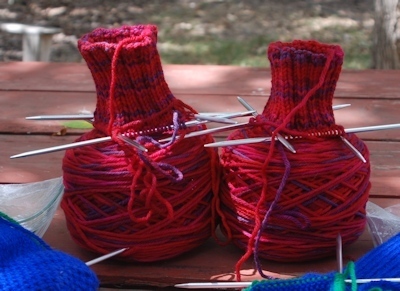
They were the secondary pair, behind the blue and green socks, and thus worked on only one or two rows at a time. I started them at DragonCon, because I could not wait to see how this yarn would knit up. But the primary pair--delayed by a couple of pairs of shorty socks for summer--had moved into serious work, and at the time of this picture were onto the feet. The Indian Paintbrush socks had to sit around with very little done on them until I finished the blue and green ones.
This week, the Indian Paintbrush socks are well onto the heel flaps, and now they look like this. It was cloudy and rainy today, so I couldn't take them outside to photograph them.
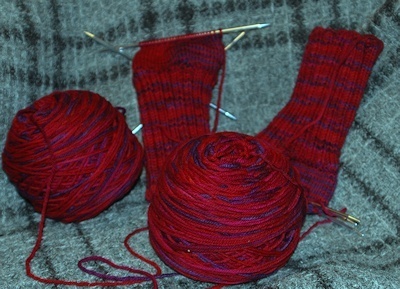
The sock on the left is upside down, showing the change from five inches of ribbing to an inch and a half of stockinette, and the one on the right is is right-side up, showing the top of the sock--you can just see the turn to stockinette toward the bottom. The purple sections of this yarn are shorter than the shades of red sections, resulting in the kinds of stripings developed. It's really interesting on the heel flaps, but those curl up at this stage--I'll post pictures of the effect later. Pulling yarn from multi-colored balls, it's hard to match the color changes exactly (luckily, I don't care) and the variations suggest design decisions. For instance, in the sock on the left you can just see the alternation of dark and red stripes up near the needles, the stockinette part. The way it worked out, this effect is very strong on one side of the foot, and on the other sock it's on the other side. When the socks are on the foot, I'll decide whether it will look better to have the darker sections on the medial or lateral sides of the feet and the socks will get their final assignment as "L" or "R". Right now, I think it'll be better to have the darker section showing on the inside, medial side, of the ankle, but that might change depending on how the foot striping develops.
In the second picture, the socks are resting on a lightweight throw woven of Herdwick wool in a waffle pattern. It's surprisingly light, but quite a nice throw to have over my legs while knitting on a cool day.
October 10, 2014
What's Blooming
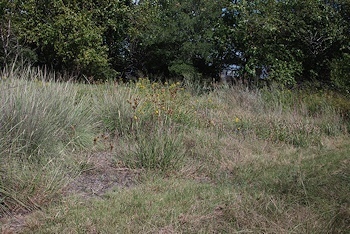
This is an area that gets runoff from the street where it dead-ends at our fence, so it's able to sustain some tallgrass species without extra watering. Before we got the 80 acres, we were already collecting native grass and forbs from construction sites where they were about to be destroyed, and replanting it here to propagate in hopes of someday having land for it. Visible in this picture are Lindheimer Muhley, Eastern gama, Indiangrass, and Switchgrass, plus Maximilian sunflower and Goldenrod, as well as the dead stalks of Eryngo that flowered a month ago. In wet years with a good spring forecast, we dig up root divisions and move them onto the 80 acres--some have done well (including Big Bluestem) but the thriving Switchgrass and Eastern Gama that was doing well on the seasonal creek bed died with the drought when the creek was bone dry all year long two years in a row.

This image of Gayfeather (magenta) and Maximilian sunflower with monarch butterfly is from another year, when the monarch migration coincided with the peak of Gayfeather and Maximilian flowering. This year they're out of synch--climate change affects their migration time as well as when these flowers bloom (and how much, as heat and lack of rainfall stunts or delays flowering. But these colors are present in and around the grass garden.
Also in bloom right now is Mealy Blue Sage, a forb that blooms when there's enough rainfall. We had a good solid rain a couple of weeks ago, so we have a good display of heavenly blue from this clump in what was the little orchard (the fruit trees all died in the drought.) Mealy Blue Sage grows on thinner drier soil (thus not in the grass garden) and among shorter grasses.

Both Goldenrod (taller) and Maximilian Sunflower are the yellow spots behind the sage. Another blue fall-flowering sage (this one flowers only in fall) is Pitcher Sage, one of the old tallgrass prairie survivors. I don't have any pictures of this year, but here's a picture from a previous year. Pitcher sage grows long and tall, to stay with the tallgrasses it used to have around it. In this shot it's leaning sideways, because its very long stalk isn't supported by surrounding tallgrasses.
 The warm-weather grasses are blooming now, both the short ones, like Buffalograss, and the tall ones: Big Bluestem, Indiangrass, Switchgrass, Lindheimer Muhley, Eastern Gama. Oh, and some of the midgrasses: Little Bluestem and Sideoats Grama. But on a windy day it's nearly impossible to get pictures of that.
The warm-weather grasses are blooming now, both the short ones, like Buffalograss, and the tall ones: Big Bluestem, Indiangrass, Switchgrass, Lindheimer Muhley, Eastern Gama. Oh, and some of the midgrasses: Little Bluestem and Sideoats Grama. But on a windy day it's nearly impossible to get pictures of that. October 7, 2014
Things Going Right
Three of the top Dallas hospitals have designated where in their hospitals an Ebola patient would be isolated and how that area would be staffed. They're ready if any of Mr. Duncan's contacts develop it or if someone else arrives sick from West Africa. http://www.dallasnews.com/news/metro/20141007-three-dallas-hospitals-set-up-special-ebola-isolation-units.ece
And then there's the judge I mentioned before: Dallas County Judge Clay Jenkins, who has shown courage, intelligence, and compassion. http://time.com/3474650/ebola-dallas-judge-jenkins/
And this church: http://www.dallasnews.com/news/columnists/james-ragland/20141007-ragland-church-offers-ray-of-hope-in-dallas-ebola-case.ece
Then there's Youngor Jallah, a member of the extended family: if not for her, Duncan might not have been back at the hospital on Sunday. Not only did she take his temperature and notice the redness in his eye, where bleeding had started, but she insisted that he go back to the hospital, called 911, and warned the EMS personnel to put on protective gear--telling them she thought it was Ebola.
http://www.dallasnews.com/news/metro/20141004-family-exposed-to-ebola-patient-is-moved-while-cleanup-continues.ece
October 5, 2014
Anniversaries
Though most of the guilt is gone--we were both humans, parent and child--we both made mistakes, often with the best intentions (but bad execution and ignorance tripping us up, both of us)--and I don't berate myself for what I can't now change, the regret doesn't die. Her life was cut short by chronic renal failure, which may or may not have resulted from a number of serious diseases she'd had earlier in her life, in the pre-antibiotic and pre-immunization days for the diseaes she caught. Polio, malaria, brucellosis, measles, then mumps as an adult, then the renal failure. She long outlived the doctor who'd told her she'd die in six months...by decades. But it got her at last, though the family tree includes women who lived well into their 90s.
So on this anniversary of her death, I think of sitting beside her, our son busy drawing with crayons in the living room while I sat by the bed. I remember the slant of light--the same slant of light we have today, and almost the same weather. But this morning I got up early to get ready for church, and this morning at the same hour as her death, I was knitting in the parish hall before choir rehearsal for the second service. At the time the funeral home's car arrived to pick up her body, I was singing the offertory anthem. And we were driving home at the time I was greeting visitors who had come to make their call on us. Everything today--including now, as evening comes on--has a corresponding memory of that day. What happened in those hours on previous anniversaries I can't recall...only that day, and this day. Tomorrow, after this many years, has blurred the day after her death. Gradually, over the years, the memory trigger shrank to just this one day. But I suspect that this one will stick, bright and clear, to the end of my own mental clarity. And that's fine with me.
Adventures With Ultraviolet Rays
You probably see where this is going.
I've noticed in the past five years or so that I don't tan the same way I used to--evenly, smoothly, without burning (I've had one bad sunburn in my life, shortly after moving back from Virginia, when I'd forgotten just how potent Texas sun is.) There were freckles, pale spots, a dry look (in someone who'd always been told her skin was oily.) This summer, when I had been riding a bike bare-armed almost every day for several months, I got a mosquito bite on my right arm. It itched, of course. I tried not to scratch, but I'd forget. Time went on. The itching lasted longer than it should. I looked at the spot--a little reddish, a little raised, dry-looking. A little sort of scaly. OK, so lotion. Eased the itch, but...I gave it two weeks of carefully, mindfully, not messing with it other than a little body lotion and of course sunscreen when going out. But no--there it was. Mildly itchy, definitely reddish, raised, scaly. I could see about 4-5 mm of raised, mildly pink, with a smaller bit of scaly-looking stuff, maybe 2-3mm across. (Judged by using my needle and stitch gauge from knitting.
So, having seen skin cancer left to become very, VERY obvious on other people, to the point of requiring a lot of cutting and then plastic surgery, I consulted a physician. Indeed, said the physician (I'm not using his exact words.) Certainly could be a small skin cancer and it's great to see one so early. Could still be "just" actinic keratosis, but that's the precursor. Good time to get rid of it. Here are the options, take your pick, but I recommend this one.
I had by then found (by feel) another smaller slightly raised area an inch or so away from the first, That one too, he said.
So I'm now using a medicine called Fluorouracil, a cancer drug that's a DNA poison and targets fast-replicating cells made up into a topical cream for surface application. After only two days of treatment, it's obviously doing something. I've been told the surface appearance will get worse, like a burn, over the course of treatment, as the bad cells die off.

This is a photo from today, Day 2, with the main concern just left of center where it looks a tiny bit pinker and definitely a different texture pattern. Hard to see, if you don't know what you're looking for. This is not the original photo, but a histogram adjustment of it, which shows the different in that area a little better. Less brown, more pink. Gamma, High, and Midtone compression all affected. It's not that different from two days ago--the differences are subtle, clear to me but you might not think, looking at the original, that there was anything but a small local irritation, maybe an insect bite.
Being able to tan easily in youth does not confer protection against skin cancer in one's senior years--quite the contrary. Had suntan lotion been greaseless and smelled like pine/spruce/fir, I'd probably have used it more--in recent years I've had and used a very heavy (still disliked) SPF 100 type when I was going to be outside after 9 am or before 6 pm, but...that wasn't enough. And in everyday chores--hanging out laundry, walking aross the parking lot to the grocery store--I figured that was such a brief exposure it didn't count.
Wrong.
Assuming that this is the usual garden-variety sun-damage type of skin cancer, it's completely treatable, and it won't "do anything." I've been checked over for melanomas (none so far.) But it's still there, and it's still a cancer, and it's still unnecessary...I could almost certainly have avoided it if I hadn't thought that I, like my mother (who never got a skin cancer despite years of sun exposure--she also tanned easily and darkly) just wouldn't ever get it. But only half my genes were hers--the other half came from a blue-eyed, lighter-skinned father.
Take-home lesson? Take the precautions. Get enough sun exposure to make your own Vitamin D, if you've got the skin for it, but don't assume the crab will never grab hold of some skin cell DNA.
High Tech Vulture Roosts
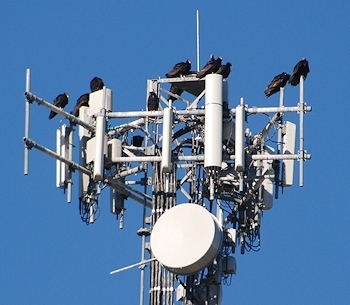
Although not all the cellphone towers around here have a steady population of vultures--and I can't quite figure out why--some are often crowded with them in early morning and late afternoon/evening. Sometimes only one species inhabits a given tower (this tower "favors" turkey vultures; another about 5-6 miles south-east has a large population of black vultures.) Occasionally a hawk will rest on a tower during the day. Cellphone towers give vultures a "lift" on by giving them clear height to take off from, plenty of room to build up airspeed.
You can tell turkey vultures from black vultures even when perched by their naked red heads. Black vultures have blackish-gray skin on the head.

This tower is not as heavily populated as the one SE of us, which in the morning before they fly often has 100 or more black vultures perched on all the cross braces, from about 12 feet above ground to the top. If I happen to drive by that tower at the right moment (as I did this morning) that means a huge crowd of black vultures flapping vigorously to get off the tower and into the air.
Cellphone towers offer a new habitat type for vultures in this area, which is poor in tall trees. Vultures do roost in trees (used to, more than they do now) but the towers are much higher and are well above obstructions like lower powerlines (some very tall powerlines are almost as tall, but not--around here--near cellphone towers.) Any new non-natural constructions offer opportunity for wildlife to make use of it in ways not foreseen or intended by the humans who built it, and cellphone towers are no exception.
October 4, 2014
One Failure Point--One Low-Tech Solution
But there's a fast, cheap, effective way to deal with this, says the writer who lives on both sides of the high tech/low-tech divide. (No dishwasher, no smartphone, but computers and high-speed internet.)
Bright-colored (I suggest yellow, the color of the traditional plague flag--bright, easily noticed if it falls to the floor, etc.) 3x5 cards easily obtained in any office supply store, plus a stamp that says "Priority", an indelible marker (probably already at the ER intake desk) .
Step one: Hospital prints out a sheet to be taped to the staff side of the intake desk. It reminds staff to ask specifically about travel or residence in Guinea, Sierra Leone, or Liberia within the past 21 days. Staff doesn't have to remember which countries--it's right there in front of them. At the foot of the sheet is the in-hospital number they're to call if they "card" someone.
Step two: Upon getting a positive answer to the question, staff person writes patient's name on one card and hands it to the patient, asking the patient to wait right there. Staff person clips second card to clipboard; if patient used that clipboard to fill out information, use the same clipboard..
Step three: Staff person 1 calls the contact number that will immediately initiate response to possible Ebola patient. Upon arrival of team to ER waiting area, staff person 1 hands off clipboard to nurse or doctor, followed by immediate handwashing while another staff person, gloved, swabs down everything the patient touched.
Advantages, besides cheap, fast, and simple: no physical contact between patient and staff is required in the ER. Contact with other parts of the hospital is minimized--transport to an isolation area is controlled by a trained team, who will have with them, both protective garments and containment for any bodily fluids that emerge between the ER and isolation. ER staff beyond the admitting office are not contaminated and will not need even brief isolation (allowing the ER to continue to function) and anyone in the ER when the possible Ebola patient arrives can be identified immediately for follow-up.
October 3, 2014
Failure Analysis and Ebola
Which leads us to the curious affair of the Dallas hospital letting an Ebola patient leave the hospital because they didn't realize he might have Ebola, even though he told them he had come from one of the countries known to be suffering an Ebola epidemic. This is, in epidemiological terms, a big-F Failure. How could a major hospital in a major US city that has a very large, international hub airport, make that mistake, a mistake with potentially deadly consequences?
That's the topic here--my own analysis, based on my experiences with medical facilities in Texas (albeit not in Dallas, but down along the Border, in San Antonio, Houston, Austin, and smaller communities here and there. I have been reading medical journals for my own enjoyment for over 40 years; I have a degree and some graduate work in biology, so I understand what I'm reading, and I"m familiar with current issues in hospital management.
The situation has been well-reported. An apparently well individual, who passed inspection at both the departing airport and subsequent transfer airports, arrived in Dallas still apparently well...but actually incubating the disease. This is a scenario that has been widely discussed in the medical literature (and in politics, for that matter) for years--that modern air travel makes it possible for someone incubating a dangerous disease to travel by air and arrive in a distant country before showing any signs of illness. Diseases have already been transported that way--measles, for instance, and influenza. In the medical journals and conferences, the possibility is known, and protocols for dealing with it have been discussed and refined.
With regard to Ebola, commentary in the main medical journals, including the possibility--even the likelihood--that a person incubating the disease might arrive in the US by air was mentioned months ago, and as the situation in West Africa got worse, as it became clear that the situation was not at all contained and the case count increased into the hundreds and then thousands, the probability rose ti near certainty. The Centers for Disease Control (CDC) and the National Institutes of Health, due to some procedural failures in their organizations, found themselves unable to respond as quickly to the growing threat as usual, because Congress forced the shutdown of CDC's only laboratory capable of rapid testing and characterization of Ebola virus in clinical samples, and then called in staff for Congressional hearings. Those politicians who distrust science and scientists, CDC's influence in epidemiology and NIH's in biomedical research, and who have insisted on cuts in budgets related to infectious disease, were having a fine time sneering at the only people who knew damn-all about Ebola, but...it's an election year. And yes, I'm both realistic and cynical. So it was almost August before CDC could get untangled from Congressional red tape and back to their real work of informing physicians and hospitals about how to respond to the Ebola situation.
Their commentary was clear; the protocol understandable to me, the non-doctor. The initial symptoms of Ebola were nonspecific--easy to confuse with other common and less dangerous disease. Fever--but not a spectacularly high fever. Headache in some, abdominal pain in others. Ebola had been mistaken in the past for upper respiratory illnesses, flu, malaria, food poisoning, a stomach virus. Therefore, in the case of travelers from the area of the outbreak, anyone with fever and any other symptoms should be immediately isolated and tested for Ebola; all personnel in contact with the patient should wear full protective gear, and any contact with bodily fluids meant isolating the contact with surveillance, including testing, for the full incubation period. Waiting for the characteristic symptoms would be a mistake, and if the person did not have Ebola, no harm was done by a day or two of isolation until the test results came back.
A couple of days after arrival in Dallas, the man from Liberia felt sick--feverish, headachy, abdominal pain--and went to the emergency room at Texas Health Presbyterian Hospital. There he told the staff at intake that he had traveled recently, from Liberia. That information was entered into a computer records. He was not admitted; he was given antibiotics and sent back to where he was staying, because (said the hospital spokesperson--not medical personnel who had contact with him in the ER) his condition did not require admittance and his symptoms were not specific to Ebola. Two days later, much sicker, he returned to the same hospital, where he was admitted and placed in isolation; tests showed that he did indeed have Ebola.
Mere trickles of information about what happened at the hospital on that first visit, that missed opportunity, have emerged: the computer record apparently edited patient travel data in such a way that the medical staff in the ER did not know he had come from Liberia. (The patient's own statement was that he told people at the hospital several times that he had, but it's not clear if he told one person repeatedly or several persons, or whether that was in triage or was said to a medical staffer.) The identities of the individual who released him, on the first visit, the person who admitted him, on the second, and the person who recognized the possibility of Ebola have not been released, so it is not possible at this time to know their qualifications and experience, or their reasons for the decisions they made, though I'm sure this has been part of the investigation. Nor do we know exactly how or why the computer record was modified so that it did not deliver the travel data to the medical personnel in the ER. This leaves a lot of room for speculation, and only the hospital to discuss in some detail.
Texas Health Presbyterian Hospital, where the patient arrived a few days after his arrival in the United States, is an 898 bed acute-care religious-affiliated nonprofit hospital belonging to a regional association, Texas Health Resources, of such hospitals. When ranked according to the typical criteria for hospitals (ER visits, ER discharges-readmissions, outcome measures for various specific conditions, etc.) THPH ranks about midway in its own association, and a little below the middle for all Dallas area hospitals. It is not a teaching hospital, and ranks well below the large teaching hospitals in Dallas. It's a middling hospital for Texas in general--many are better, many are worse. But it's not where you'd want to go if you had a serious unusual problem, a critical illness that was being seen in that facility for the first time.
This was obvious to me even before I looked up the hospital and its rankings. A first-rank hospital's senior staff, especially the chief of infectious disease, would have been well aware of the progress of the Ebola outbreaks in West Africa, well aware of the hospital's chances of seeing persons from that area, and would have kept on top of current recommendations for handling a sick person who had been in those countries. The possibility would have been discussed with other doctors, with any medical staff who might come into contact with such a person, and the ER's ability to recognize a potential Ebola case would have been assessed and improved. Not just the ER doctors, but the nurses, the aides, and particularly those who did intake--who gathered information from the patients as they arrived. Staff would be reminded repeatedly that anyone arriving from anywhere in West Africa with a fever should be considered a potential Ebola patient. That travel history was vital, and the full information must get to the medical personnel evaluating the patient. They might not have been able to get the entire nursing staff trained in the elaborate safety measures needed to care for an ward full of Ebola patients, but they would almost certainly have given extra training to the team they planned to assign to do it for one patient.
None of that happened at THPH. Ebola was not even suspected at the first visit, despite this person's having typical early symptoms of Ebola and being from one of the outbreak countries.
But there's another clue to this failure, and it's also from the first visit ER record. The patient had fever and reported abdominal pain, and he was given antibiotics without testing for any of the bacterial causes of abdominal pain. The routine administration of antibiotics for abdominal pain and moderate fever is...no longer best practice. Hasn't been for decades. Most stomach/gut upsets are viral in origin. Unless the pattern of the illness suggests one that is bacterial--and research has shown that a specific antibiotic works against that particular bacteria, antibiotics are not given. (Among other things, antibiotics disturb the intestinal flora, resulting in more problems.) Overuse of antibiotics has other consequences and first-rank hospitals and clinicians know that.
So here's a hospital that is not keeping up to date on common things--the person with a fever and abdominal pain--is it any surprise that it's not keeping up on something new, exotic, unexpected. And that brings up another question. Why would a large hospital in a large city, a city with excellent teaching hospitals, not want to catch up, to be better, to be, in fact, excellent? A variety of answers are possible. Perhaps they believed their own website and thought they already were excellent. Perhaps they felt constrained by financial concerns and skimped on education and training because it would cost more. Perhaps they did not believe anyone with Ebola would ever show up in their ER--surely such a person would go to one of the teaching hospitals or a public hospital. Perhaps they felt politically motivated resistance to instructions coming from CDC. It's important to find out what their motivation for lack of preparedness was.
And when the analysis is finished--when it's known exactly who made which decisions that led to the failure to recognize the possibility of Ebola on that first visit--it's then time to figure out how to prevent another such failure. How to motivate all hospitals to make the changes necessary, to take time and money to train nurses and other staff. How to compensate hospitals for the costs involved in treatment. It is doable. It's been done elsewhere, with fewer resources than we have. But to accomplish it--to make every hospital in the nation capable of recognizing and safely caring for an Ebola patient--we must pursue every failure even if it bruises some feelings.
October 2, 2014
Finally: Blue & Green Socks Finished
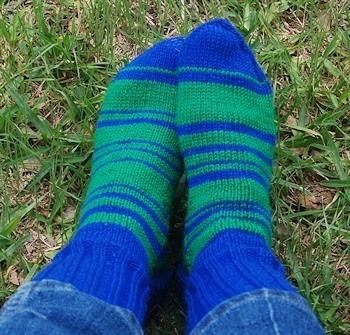

This green yarn is the one that doesn't photograph true, Ella rae Classic #90--it's darker, a rich emerald, so the contrast with the blue is much less in terms of light/dark, and more in terms of pure hue. I really like the colors together. I was pushing to finish them in the last week of September and ended up with a longer blue stretch on one toe than the other, but...since I wear them with shoes, who will see them to point out the mistake? I wear them with shoes. It's our little (*ha*) secret. As usual, I put them on right away and wore them the rest of the day, which I find "sets" the fit well. Today they've had their first wash and though they may not finish line-drying today (didn't get them out first thing as it was cloudy and looked like it might drizzle) they will benefit from the experience. Young socks need to be exposed to the real world (yes, that is sort of a joke. OTOH, I think line drying improves many things, esp. on a breezy day like this.
The new "leading" pair on the needles is the variegated red/purple Mountain Colors "Indian Paintbrush" yarn. Next up on the needles these came off of--the next "following" pair--will be a pair of Herdwick yarn socks, the super-warm & durable coldest-days-of-winter sock.


They feel wonderful on a cold day! I could stand sock-footed on our kitchen floor when it was in the 20sF outside (and the house has a crawl space--that kitchen floor gets COLD--and my feet did not chill at all. I couldn't feel the cold coming through. I don't need lots of pairs of these--we don't have that many days in a row of serious cold--but I want enough pairs that the first-cold-day's socks have time to dry before the end of the cold spell. And it can take them four days to dry indoors in cold weather. So 4-5 pairs.
Elizabeth Moon's Blog
- Elizabeth Moon's profile
- 2621 followers



